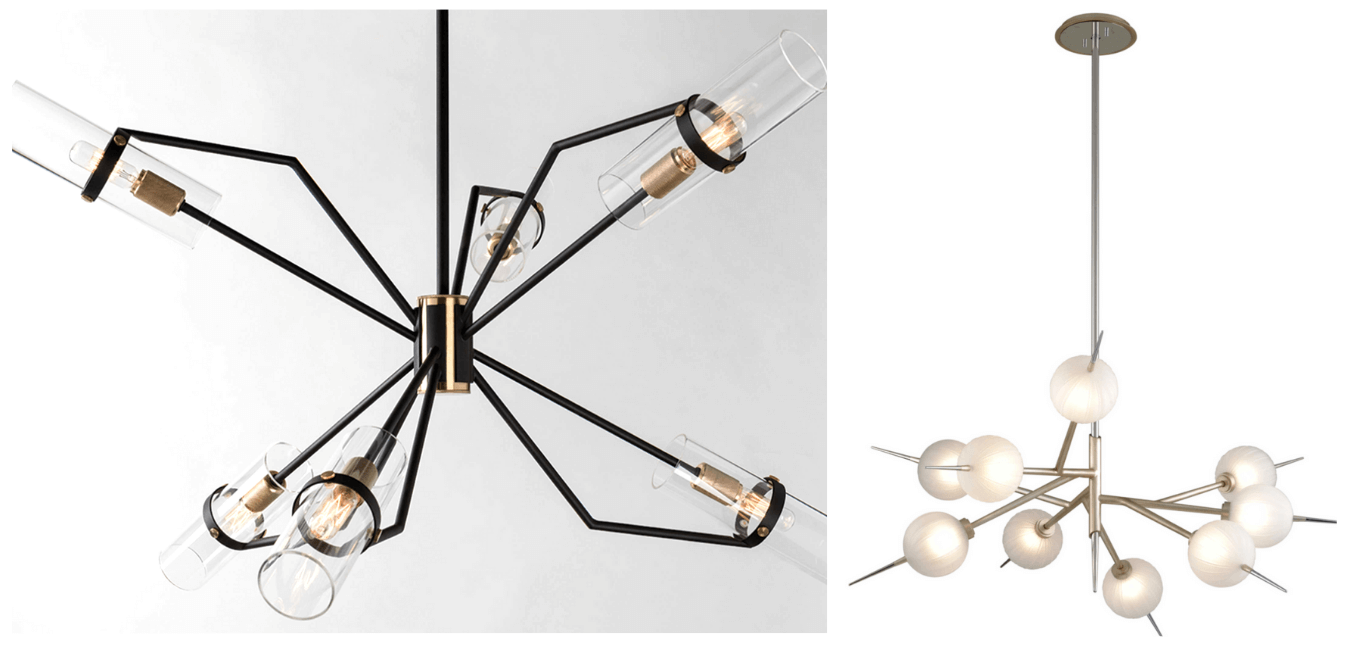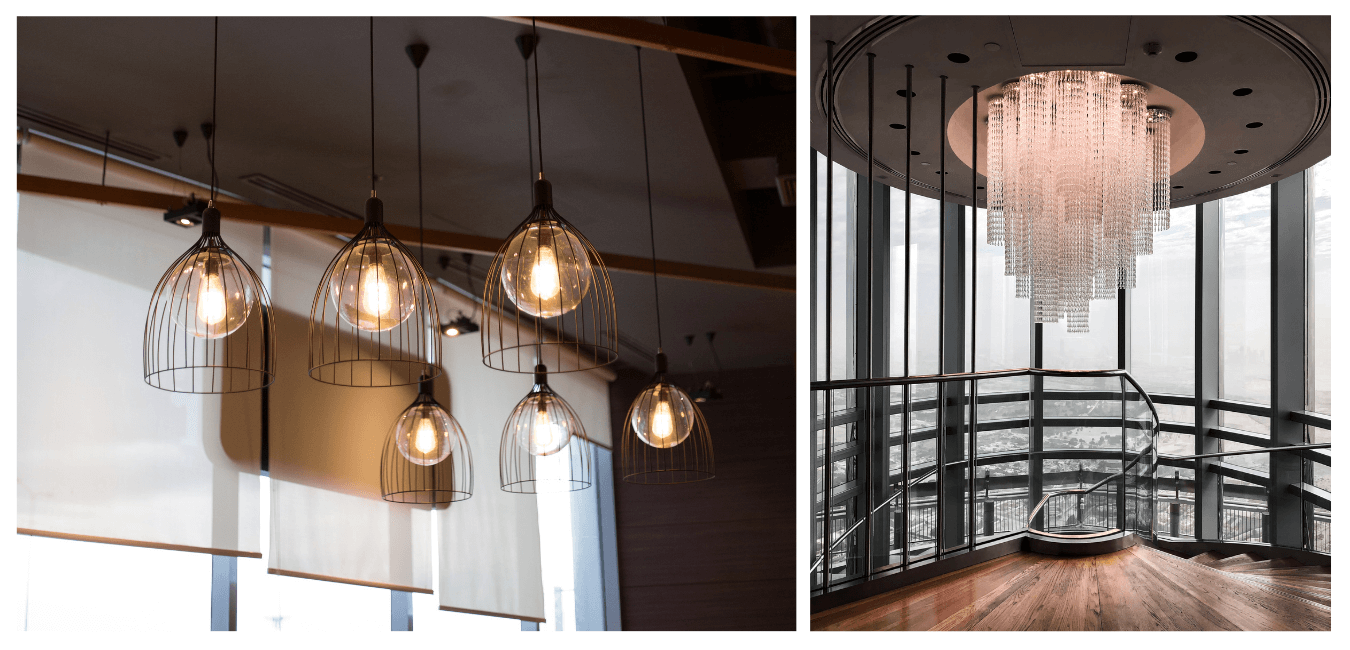Your entry is the first thing anyone sees when they walk inside your home, so setting the tone with warm and effective lighting is key to a good impression.

Pictured on the Right: Troy Lighting Gotham Aged Silver 12-Light 38'' Wide Chandelier from TopModern
Finding the perfect chandelier for your home’s entryway can be a challenge. One might wonder if it should grace the covered porch or be strung up towards the ceiling of the foyer. Either way, choosing the right chandelier adds enormous pressure because the piece will function as the focal point of any space it graces. Thankfully, a number of chandeliers are available on the market today — from crisp and contemporary to nostalgic and traditional. Follow our guide for tips to picking the perfect entryway chandelier — no matter the style, shape or size of your foyer.

Pictured on the Left: Troy Lighting Raef Textured Bronze Six-Light 50'' Wide Chandelier, Pictured on the Right: Corbett Lighting Tempest Satin Silver Leaf 42'' Wide Glass LED, Both from TopModern
According to the Home Stratosphere article “34 Chandelier Styles and Shapes for Your Home,” there are over thirty different types of chandeliers. These classic, elegant light fixtures range in style from eccentric and contemporary to traditional and ornamental. They also range in size and diameter — from a single layer much like a pendant light to five tiers that tumble down from the apex in a sophisticated waterfall of crystal.
The Home Stratosphere lists the twelve most common types of chandelier as “shaded, crystal, candle-style, mini, drum, sputnik, empire, waterfall, center bowl, island, globe and cage.” A shaded chandelier very much resembles a pendant light, as it is hallmarked by “brushed glass surrounding the individual lights” in a series of branches. These are often found above dining tables, kitchen bars and bathroom sinks. Crystal and candle-style chandeliers are two classics.

Pictured on the Left: Fontana Arte 19-Lights 59'' Wide Grand Chandelier, Pictured on the Right: Corbett Lighting Nexus Silver Leaf 16-Light 50'' Wide LED Chandelier, Both from TopModern
The first is what one imagines when picturing the opulent chandeliers of Old Hollywood mansions — a cascade of glittery glass cut into various shapes on a gold string. Candle-style chandeliers are still used in modern households and may be either traditional in silhouette or wholly modern. The modern candle-style chandeliers involve false candles affixed to a metal ring that simultaneously evokes contemporary sensibilities and those of medieval Europe.
As the name suggests, mini chandeliers are designed for small spaces — particularly apartments, laundry rooms, mudrooms and bathrooms. Mini chandeliers are often executed in the “drum” style, which is also self-explanatory. Sputnik chandeliers are perhaps the most exciting. Extraordinary modern and often industrial in nature, they explode from the ceiling like stars or suns — with radiating posts topped by spherical bulbs. The final five — waterfall, center bowl, island, globe and cage — are all also self-explanatory in nature, resembling their namesakes perfectly.
Because your home's chandelier will be the first thing guests view when entering your house, it is one of the most important design elements — and arguably the most significant light fixture — within the entire space. Though choosing the style, shape and size of the piece can be difficult, there are five things to consider when buying a foyer chandelier that works for your home.
First, determine your interior design style. Second, understand the size of your space and third, decide on the placement of your chandelier in the foyer. Last, figure out the required maintenance for a chandelier in your home, as those mounted high up towards the ceiling. Follow below to learn more about the five things to consider when buying an entryway chandelier.

Pictured on the Right: Hudson Valley Lighting Tupelo Aged Brass / Black 4 20'' Wide LED Glass Mini Chandelier, from TopModern
According to the Home Design Article “10 Helpful Tips in Buying a Chandelier,” determining your home’s interior design style is the most significant step in picking the perfect chandelier for your space. The article recommends that “before you get a chandelier, you should have decided on the kind of interior you want.” Whether your space is “modern, traditional, contemporary, eclectic” or something else, there is a chandelier that works for your home. The trick is determining which will fit with your home’s architectural and interior design scheme.
Matching or closely pairing the material of your chandelier — whether pale silver or striking matte brass — can go a long way to creating a cohesive lighting program. Another element to consider is the shape of the fixture. Square and rectangular shapes pair best with modern, contemporary and farmhouse-inspired spaces. Curving, elongated chandeliers work best with traditional interiors — particularly when accented with yellow gold or teardrop light bulbs.

Though most entryways are slim in square footage and tall in height, they do vary from home to home. In her article “How to Determine the Right Chandelier Size for Your Room” for The Spruce, Lauren Flanagan writes that “a simple way to determine a chandelier size is to add the dimensions of the room together in feet and then convert the answer to inches.” The answer to this math problem — measured in inches — “should equal the diameter of the fixture,” writes Flanagan.
As such, if the space you intend to place the chandelier within measures ”10' x 14' the diameter of the fixture should be about 24.” Flanagan notes that if you plan to hang a chandelier above any piece of furniture — whether a dining table or a credenza — you should “take the size of the table into account” as well.

Pictured on the Right: Hudson Valley Lighting Angler Aged Brass 4 15'' Wide Mini Chandelier, from TopModern
Build With Ferguson’s Yvonne Harbison notes that “a chandelier can work in almost any room, depending on the overall style you’re going for in the space.” Chandeliers are available in a wide variety of sizes, so placement in any space is reasonable as long as an appropriate scale is established. While chandeliers will work in any room, Harbison writes that “you do have to be careful to pick the right chandelier for the right space [as] a full sized chandelier in your bathroom would likely look ridiculous and a mini-chandelier over your dining room table only makes sense if your table and dining room are on the smaller size, or if you decide to hang multiple mini chandeliers in the space.”
To determine the right scale and placement of a chandelier in your entryway, Harbison recommends homeowners consider the “style of the room,” “the amount of lighting needed” and “the size of the room.” Homeowners should make sure “the colors and design of the chandelier you’re considering match the overall space.” They should also consider the amount needed because while “the big appeal of chandeliers is that they’re beautiful...they also have a practical job to do.” If the plan is to illuminate a large entryway when guests arrive or when residents come home from work, the chandelier must emit an acceptable amount of functional light — directed in an appropriate way. Lastly, homeowners should “make sure the size of the chandelier is appropriate to the space available.”

Pictured on the Right: Oggetti Stillabunt Gold White 25'' Wide LED Pendant, from TopModern
If your space is modern and unconventional, avoid settling for conventional chandeliers decked out in crystal and gilded metal. With so many styles available on the market today, there is no reason to sacrifice style in the name of tradition when choosing your foyer chandelier. Whether your home exudes Art Deco flair, Old Hollywood Glam or subtle Mid-Century Modern majesty, TopModern has a chandelier that works for your style and your space.
For instance, we love the Hudson Valley Washington Aged Brass Four-Light 16'' Wide Mini Chandelier for its specialty, hand-crafted glassware and folkart feel. We also love the trapezoidal Hinkley Lighting Fulton Bronze Four-Light Mini-Chandelier for its streamlined, nearly nautical look that fits in well with both ultra-contemporary and country homes.

Pictured on the Right: Corbett Lighting Dolce Champagne Leaf 12-Light 25'' Wide Pendant Light, from TopModern
The amount of maintenance required for your chandelier is determined by the materials used to create the piece and the placement of your light fixture. Upkeep of the lighting fixture’s wiring might also be necessary — and could be difficult to address if wires are fied in a vaulted portion of your ceiling. Choosing a low-effort chandelier might be best if you plan to raise it high above the floor in your entryway, as a ladder would be needed to clean or polish the piece. Some types of chandeliers — such as transparent, crystal pieces — require more maintenance than others — like those that are not as prone to developing cloudiness or patina.
Additional support might also be required to keep your chandelier in tip-top shape, writes Bill Lewis in his article “Before You Buy a Chandelier: Choosing the Chandelier That's Right for You and Your Room” for The Spruce. Lewis notes that “most chandeliers are heavier than other light fixtures, and chandeliers with crystals can be particularly heavy.” Given this, some chandeliers can weigh upwards of fifteen or twenty pounds. If your chandelier does exceed this weight, “you'll need to install a special electrical box, just as you would if you were going to install a ceiling fan.”

While chandeliers are typically more expensive than pendant lights, they often have a more significant visual impact and act as the primary focal point of a space. In an entryway, chandeliers offer usable light, stunning sparkle and varying degrees of drama. According to Fixr’s article “Pendant vs Chandelier,” the basic differences between chandeliers and pendant lights are their appearance and the way in which they are installed, though they “also differ in the way they’re used.” Because they are slimmer, pendant lights are ideal for small spaces and cramped quarters.
The Fixr article notes that, “for workspaces, such as the kitchen or laundry room, [a pendant light] does a good job brightening up a dark spot.” Chandeliers — on the other hand — add “elegance to any room,” providing both “a source of light [and] hanging decoration.” The article notes that “proportion is essential” in chandeliers because they have multiple parts, while pendants offer only a single shaded element. Chandeliers are more varied than pendants — available in “crystal, tiered, downlight, transitional, and rustic” styles — among many more. They are also found in varied sizes, including “mini, small, medium, large, entryway, dining room, living room, and bathroom chandeliers.” However — like pendant lights — proportion is important when considering a chandelier.